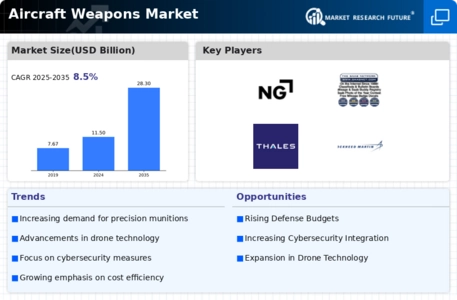Market Trends
Key Emerging Trends in the Aircraft Weapons Market
The aircraft weapons market is witnessing significant trends driven by geopolitical tensions, technological advancements, and evolving military strategies. Aircraft weapons play a crucial role in modern warfare, enabling military forces to project power, deter adversaries, and achieve strategic objectives. One notable trend in the market is the increasing demand for precision-guided munitions (PGMs) and smart weapons that offer enhanced accuracy, lethality, and mission effectiveness. Military forces are investing in advanced air-to-air missiles, air-to-surface missiles, guided bombs, and standoff weapons capable of targeting enemy assets with precision while minimizing collateral damage. Additionally, there is a growing focus on developing autonomous and network-enabled weapons systems that can operate in contested and denied environments, providing military forces with greater flexibility and operational resilience.
Moreover, advancements in sensor technology and data fusion are driving market trends in the aircraft weapons sector. Sensor technologies such as radar, infrared, electro-optical, and synthetic aperture radar (SAR) enable aircraft weapons to acquire and track targets with high precision and reliability, even in adverse weather conditions and low-visibility environments. Additionally, data fusion algorithms and artificial intelligence (AI) techniques allow for the integration of sensor data from multiple sources, enhancing situational awareness and target discrimination capabilities. As military forces seek to maintain a technological edge on the battlefield, the adoption of advanced sensor and data fusion technologies in aircraft weapons is expected to increase, driving market growth and innovation.
Furthermore, market trends in the aircraft weapons sector are influenced by shifting geopolitical dynamics and security threats. Rising tensions between nations, territorial disputes, and asymmetric threats from non-state actors are driving demand for aircraft weapons systems that can provide a credible deterrence and rapid response capability. Military forces are modernizing their aircraft fleets and arming them with advanced weapons to counter emerging threats and maintain strategic superiority. Additionally, there is a growing emphasis on developing multi-role and multi-domain weapons systems that can address a wide range of threats and operational scenarios, from air-to-air combat to precision strike missions and maritime interdiction operations.
Additionally, the integration of stealth and electronic warfare capabilities is shaping market trends in the aircraft weapons sector. Stealth technology allows aircraft to evade enemy detection and engage targets with reduced risk of counter-detection and interception. Military forces are investing in stealthy aircraft platforms such as stealth fighters, bombers, and unmanned aerial vehicles (UAVs), which require specialized weapons systems optimized for stealth and survivability. Additionally, there is a growing demand for electronic warfare (EW) weapons and countermeasures that can disrupt enemy communications, radar systems, and missile guidance systems, enabling aircraft to operate in contested airspace and deny adversaries access to critical areas.
Moreover, market trends in the aircraft weapons sector are influenced by budgetary constraints and defense spending priorities. As defense budgets come under pressure from competing priorities and fiscal constraints, military forces are seeking cost-effective solutions to modernize their weapon systems and maintain operational readiness. Companies are responding to this trend by offering affordable and modular weapons systems that can be upgraded and adapted to meet evolving threats and mission requirements. Additionally, there is a growing emphasis on international collaboration and joint development programs to pool resources, share costs, and achieve economies of scale in the development and procurement of aircraft weapons.
Furthermore, market trends in the aircraft weapons sector are driven by the increasing demand for integrated and network-centric warfare capabilities. Military forces are seeking to enhance interoperability and information sharing among air, land, sea, and space-based assets to achieve greater operational synergy and effectiveness. As a result, there is a growing demand for aircraft weapons systems that can seamlessly integrate with command and control networks, intelligence, surveillance, and reconnaissance (ISR) platforms, and other battlefield assets. Additionally, there is a trend towards developing network-enabled weapons systems that can receive real-time targeting data and guidance updates from off-board sources, enabling precision engagement of time-sensitive targets and reducing the reliance on onboard sensors and targeting pods.








Leave a Comment